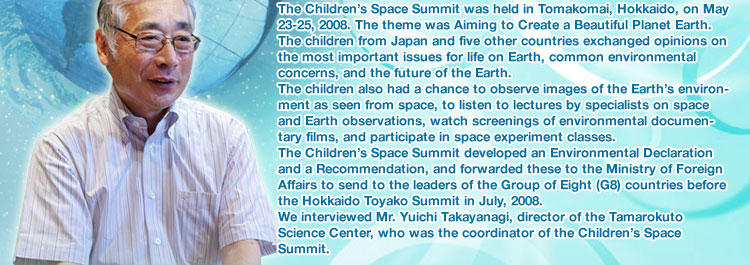

Yuichi Takayanagi
Director, Tamarokuto Science Center
Mr. Takayanagi graduated from the Department of Physics at the University of Tokyo in 1964. After receiving a Master's degree in Physics from the Graduate School of Science at the University of Tokyo, he joined NHK (Japan Broadcasting Corporation). He then held a chief producer's position at the NHK Special Program Department, before becoming a member of the News Commentators Division in 1994. In 2001, Mr. Takayanagi was appointed a professor at KEK (High Energy Accelerator Research Organization). In 2003, he became a professor at the Cooperative Research Center, at the University of Electro-Communications, while still holding his position in the News Commentators' Division at NHK. He became a Director of the Tamarokuto Science Center in 2004. Asteroid No. 9080 was named Takayanagi in his honor. His main publications include Seeds of Creation (NTT Publications), Landing on Mars (NHK Publications), and Planet Hunter (Benesse Corporation). He coordinated the Children's Space Summit held in Tomakomai, Hokkaido, in May 2008.
Director, Tamarokuto Science Center
Mr. Takayanagi graduated from the Department of Physics at the University of Tokyo in 1964. After receiving a Master's degree in Physics from the Graduate School of Science at the University of Tokyo, he joined NHK (Japan Broadcasting Corporation). He then held a chief producer's position at the NHK Special Program Department, before becoming a member of the News Commentators Division in 1994. In 2001, Mr. Takayanagi was appointed a professor at KEK (High Energy Accelerator Research Organization). In 2003, he became a professor at the Cooperative Research Center, at the University of Electro-Communications, while still holding his position in the News Commentators' Division at NHK. He became a Director of the Tamarokuto Science Center in 2004. Asteroid No. 9080 was named Takayanagi in his honor. His main publications include Seeds of Creation (NTT Publications), Landing on Mars (NHK Publications), and Planet Hunter (Benesse Corporation). He coordinated the Children's Space Summit held in Tomakomai, Hokkaido, in May 2008.
Q. What kind of program was the Children's Space Summit?

The Opening Ceremony of the Children's Space Summit
(Courtesy of Young Astronauts Club - Japan)
To understand the Earth's environment globally, eyes from space are very important. Various issues currently affecting the Earth are borderless. When you see the Earth from space, none of the political boundaries show up, and all the environmental issues look connected. The Earth's environmental problems caused by human beings vary over the Earth's surface according to population density patterns. By observing the environment from space, we can understand the connections between human activity, political regions, and the condition of the environment. It is vital that our children learn how to use the scientific tools we now have to solve Earth's problems and find a path to the future.
This year, the G8 Summit, in which global leaders discussed environmental and energy issues, was held in Toyako, Hokkaido, Japan. We used this opportunity to bring suggestions from the Children's Space Summit to the G8 Summit. It is good for world leaders to hear children's perspectives on how we should act in the future.
Q. What was the age range of the children gathered, and what was discussed?

A scene from a branch meeting
(Courtesy of Young Astronauts Club - Japan)
The children ranged from Grade 5 to Grade 11. Twenty of them were selected from 95 applicants in Japan, and nine students participated from abroad. The international participants were from South Korea, China/Hong Kong, Indonesia, Australia and Tuvalu. Tuvalu is a coral island country in the South Pacific that faces the possibility of vanishing as sea levels rise due to global warming.
Separate discussions focused on the following themes:
- What we lose as a result of environmental problems
- What human beings can do to help
- What role space might play in environmental solutions
- The role of science and technology
- The role of children in environmental solutions
Groups were formed divided evenly among boys and girls, and across age ranges. Adults facilitated the group discussions. The group I joined discussed the topic "What human beings can do to help." I tried to give the children a hand when they needed it while still respecting their opinions. The group chose a leader and a secretary, and assigned other roles to other group members. I think it went very well, especially in terms of content. The results from the discussions were summarized as a list of suggestions, and in an environmental declaration titled "Our Hopes."
* Related link: the Environmental Declaration and the list of suggestions?from the Children's Space Summit
Q. What particularly impressed you during the children's discussions?

Mr. Takayanagi talking with children during a branch meeting
(Courtesy of Young Astronauts Club - Japan)
At a branch meeting I attended, participants discussed how to spread the Japanese word "Mottainai" ("Shame of Waste") as an international keyword to save the Earth from environmental problems. This Mottainai spirit has been a requirement for Japanese people since ancient times in order to live on this small nation of islands. I was impressed that the children spoke about a concept from elder generations, something our people have known long before the world become aware of environmental problems and the solutions required.